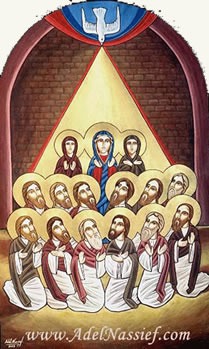- Arabic Corner
- Audio
- Bible Study
- Coptic Reader
- Children's Corner
- Deacons
- Evangelism & Apologetics
- Evangelism Pamphlets
- Interesting Facts
- Literature
- Pigori Productions
- Priests Corner
- Questions & Answers
- Reading Recommended
- Saintly Studies
- Servants Guide
- Sunday School Curriculum
- Sunday School Curriculum-Special Needs
- Youth Corner
Interesting Holy Bible Facts
Feast of Pentacost – The Feast of Feasts

The Feast of Pentecost, or "the fiftieth", is not just one feast, but several feasts in one:
- Feast of the Resurrection
That day is the last of the Holy Fifty Days of the Resurrection and a procession for the Resurrection is done in Matins Raising of Incense. - Feast of the Ascension
The original day of the celebration of the Ascension of our Lord was actually on the fiftieth day, not the fortieth from our Lord's Resurrection from the dead. It is documented in the Pilgrimage of Egeria from the 4th century that the bishop of Jerusalem celebrated the fortieth day with a very regular liturgy in Bethlehem. However, on the fiftieth day, part of the celebration was done on the Mount of Olives from where our Lord ascended to the heavens and the readings were all about the Ascension. We have the same rites in our Sagda, or Worship, service when we, in the second Sagda, read the passage from the Gospel according to St. Luke, chapter 24, about the Resurrection and Ascension of our Lord. - Feast of the Descent of the Holy Spirit
As written in the Holy Book of Acts, chapter 2, the Holy Spirit descended upon those in the upper room as tongues of fire and they spoke in tongues. We call this day the "Birthday of the Church" because through the descent and dwelling of the Holy Spirit with the faithful, they became attached to Christ as branches to the vine (John 15:1-8) and one in the Body of Christ, i.e. the Church, (Eph 1:22-23; Col 1:24). Thus, through the dwelling of the Holy Spirit with the faithful, they become a part in the kingdom of God beginning here on earth. - Second Coming of Christ
In the Old Testament, the fiftieth day was also several feasts in one. It had several names such as the Feast of Weeks, Feast of the Harvest, and Feast of the Firstfruits (at the end of the harvest). It was one of three major feasts in which all firstborn males were to be present in Jerusalem to offer sacrifices along with the Feast of the Firstfruits (at the beginning of the harvest) and the Feast of Tabernacles (Ex 23:15-17; Deut 16:16; 2 Chr 8:12-13). The Feast of the Firstfruits (at the beginning of the harvest) always fell on the day after the first Sabbath following the Passover. So the Feast of Weeks, i.e. the fiftieth day, was seven weeks from the Feast of Firstfruits (Ex 34:22; Num 28:26; Deut 16:10). So it was a Sabbath of Sabbaths. Since barley appeared first amongst the crops, it was offered on the Feast of the Firstfruits (at the beginning of the harvest). But by the time of the Feast of Weeks, the wheat had appeared and it was harvested. Thus, it was also the Feast of the Harvest and a Feast of the Firstfruits.
It is the same in the New Testament. The Resurrection of our Lord Jesus Christ occurred on the same day as the Feast of the Firstfruits of the Jews. So the descent of the Holy Spirit occurred on the Pentecost, the fiftieth. Thus, it is a reminder of the preparation for that final harvest on the last day when the general resurrection will occur and all will be judged. Christ is the firstfruits of the resurrection and when all rise from the dead on the last day and the judgment occurs, it will be the final fulfillment of the salvation of the righteous for eternal life with Christ in His kingdom, a Sabbath of Sabbaths.
Of note, the first Pentecost in the Old Testament, i.e. the fiftieth day following the first Passover, was the day that the cloud of God's presence descended on Mount Sinai and Moses began to receive the law. Thus, this feast is also a celebration of God's presence with His people, teaching and guiding them into all that is necessary for life with Him according to His will. This is also related to the judgment in the last day since each will be judged by the words and commandments of our Lord Jesus Christ (John 12:47-50) of which the Holy Spirit is always teaching and reminding us (John 14:26).
Notice also that the description of God's presence on Mount Sinai included smoke, fire, lightnings, thunderings, the sound of a trumpet, and quakings (Ex 19:16,18). This is why when St. Peter says the prophecy of Joel the prophet in Acts 2:17-21, he was not only speaking of the gifts of the Holy Spirit, but also of events related to the last day:
"And it shall come to pass in the last days, says God, That I will pour out of My Spirit on all flesh; Your sons and your daughters shall prophesy, Your young men shall see visions, Your old men shall dream dreams. And on My menservants and on My maidservants I will pour out My Spirit in those days; and they shall prophesy. I will show wonders in heaven above and signs in the earth beneath: blood and fire and vapor of smoke. The sun shall be turned into darkness, and the moon into blood, before the coming of the great and awesome day of the Lord. And it shall come to pass that whoever calls on the name of the Lord shall be saved" (Acts 2:17-21).